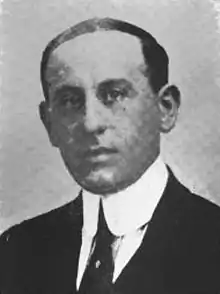Julius Miller
Julius Miller (January 12, 1880 – February 3, 1955) was a Manhattan Borough President from 1922 to 1930, who is best remembered for pushing through the West Side Elevated Highway from 72nd Street to the tip of Manhattan.


Life
He graduated from New York Law School and became an attorney in 1901.[1] Miller was a member of the New York State Senate (17th D.) in 1919 and 1920.[2] He was borough president of Manhattan from 1922 to 1930. In 1924 he was an alternate delegate to the 1924 Democratic National Convention. In 1933 he became a Justice of the New York Supreme Court (1st D.), and served until 1950.
As Borough President, he promoted the construction of the Park Avenue Viaduct through the New York Central Building and around Grand Central Terminal, the establishment of the center strip on Park Avenue, and the replacing of the Sixth Avenue elevated train. As a judge Miller claimed the distinction of never having been reversed by an appellate court on any of the cases in equity where he decided suits without a jury. This was believed to be unique among New York jurists.
In 1930, Miller received The Hundred Year Association of New York's Gold Medal Award "in recognition of outstanding contributions to the City of New York."
Miller retired in 1950, and died at his home in New York City on February 3, 1955.[3]
References
- Geyer's Stationer, New York: Julius Miller, Volume 72, October 27, 1921, page 15
- J. B. Lyon Company, The New York Red Book, 1919, page 119
- Long Island Newsday, Newsday Obits February 1955, Obituary, Julius Miller, transcribed by Terasa Ahlgren
External links
| New York State Senate | ||
|---|---|---|
| Preceded by Courtlandt Nicoll |
New York State Senate 17th District 1919–1920 |
Succeeded by Schuyler M. Meyer |
| Political offices | ||
| Preceded by Henry H. Curran |
Borough President of Manhattan 1922–1930 |
Succeeded by Samuel Levy |
